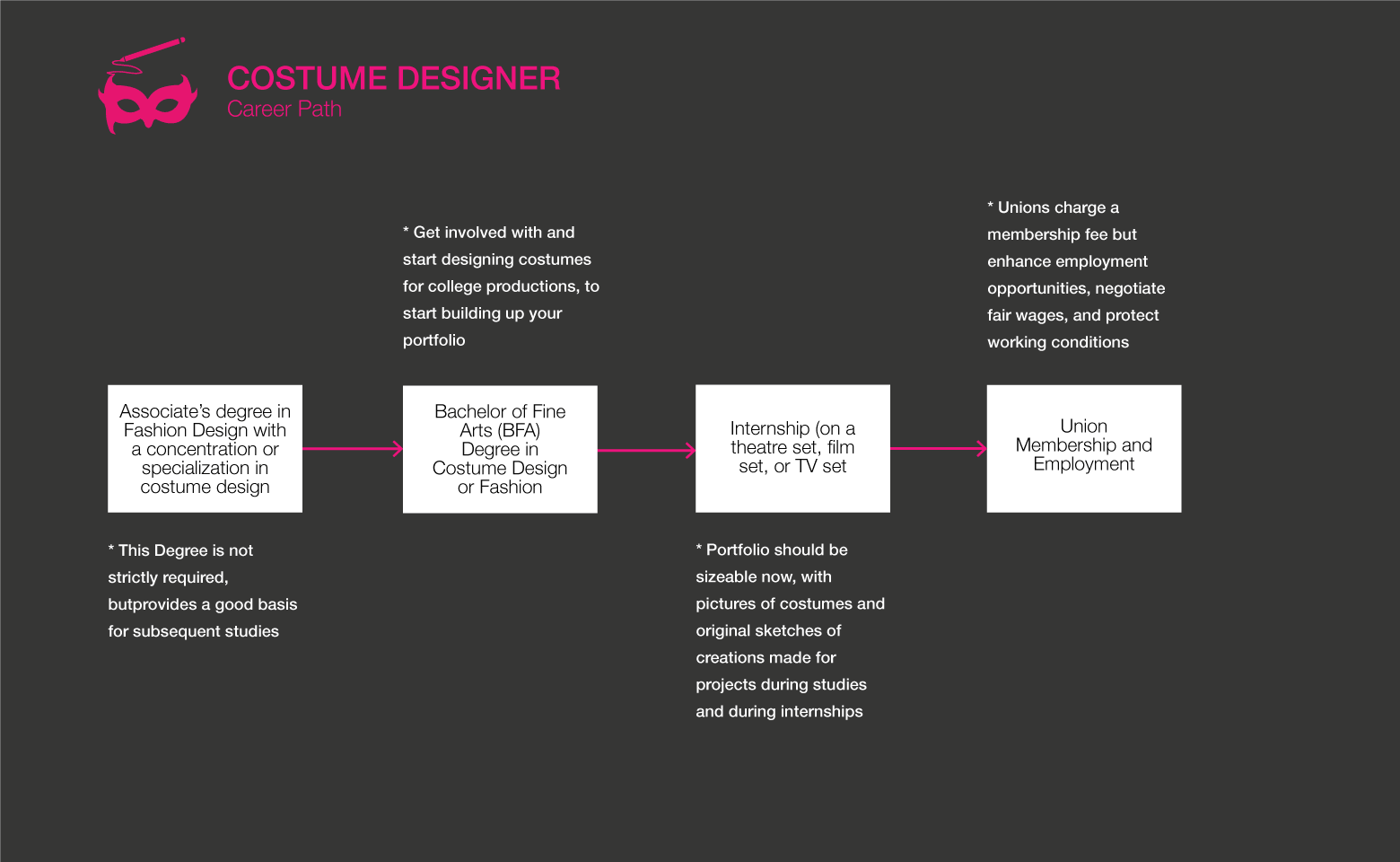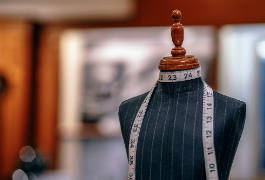Spotlights
Tiêu đề tương tự
Wardrobe Designer, Fashion Designer (specific to costume design for film, TV, or theater), Theatrical Costume Designer, Costume Coordinator, Wardrobe Supervisor, Costume and Wardrobe Specialist, Costume Director, Wardrobe Consultant, Costume Stylist, Wardrobe Master/Mistress
Mô tả công việc
Costume designers collaborate with the director and the set and lighting designers of a production, to create the look of each character by designing clothes and accessories the actors will wear in performance.
Các khía cạnh bổ ích của sự nghiệp
- Realize a passion for creating and storytelling
- Producing work that means a lot to people, especially fans of a show, is very meaningful
- Living up to fans’ expectations is very fulfilling
Muỗng bên trong
Trách nhiệm công việc
Pre-production Days:
- Receive script about 4 months before filming begins
- Conduct research, or sourcing on the internet: e.g. historical research, if the project is a period drama
- Some original projects may allow for more creativity and so require less preliminary research
- Sketch, design, decide what fabrics will be used
- Sizing information on the cast will be received about 3 weeks before filming begins (This is an unpredictable period where last minute castings or recastings may affect the sizing information, so a costume designer may have to create several pieces of their costume at different sizes)
- Costumes are typically created before the costume designer even arrives on set, to ensure the shooting process can happen more efficiently
On-Set Days:
- These are typically very long days!
- Makeup and wardrobe departments are usually the first on set, arriving at very early hours to prepare the cast for shooting
- Costume designers must also track scenes for continuity during filming (e.g. if a character is wearing a certain accessory in one take of a scene they must be wearing it in another take of the same scene)
- Depending on the project, the length of filming and the number of copies of each costume, costume designers may also have to run costumes through laundry and make reparations to the costumes frequently
Kỹ năng cần thiết
Kỹ năng mềm
- Active listening (responding and asking pertinent questions)
- Coordination/Organization
- Creative thinking
- Decision-making/Problem-solving
- Linh hoạt
Kỹ năng kỹ thuật
- Artistic ability (e.g. sketching skills)
- Sewing skills (highly desirable, not strictly required)
Các loại tổ chức khác nhau
- Union and Non-Union projects
- TV
- Film
- Theatre
Kỳ vọng/hy sinh cần thiết
- As with many artistic careers, have to deal with rejection and a lot of competition
- Sacrificing time with family, due to an erratic work schedule
Xu hướng công nghiệp hiện tại
- Experimenting with smart textiles
- Current Film and TV scripts seem to be leaning back towards the sci-fi genre, which awards a lot of creative leeway to costume designers
Những điều gì mọi người trong sự nghiệp này thích làm khi họ còn trẻ ...
- Reading and watching movies/TV show, which develops a passion for storytelling
- Sketching
Giáo dục và đào tạo cần thiết
- No formal education strictly required (but it is considerably more difficult to find employment without a certificate or degree)
- Bachelor’s in Fashion Design or Costume Design is preferable
*Note: Ensure the legitimacy of the design course and university you are attending by speaking with previous graduates to gauge their experience and success following graduation
- Apprenticeship and/or experience
- The National Association of Schools of Art and Design accredits several relevant college programs
- Sample course topics include drawing, color science, fashion history, construction and draping, designing for dance, stage, and film, patterns, sewing, knitting makeup, jewelry, styling, special effects, textiles, fabrics, millinery (hat-making), computer-aided design, digital photography, lighting, and writing
- Internships and projects completed during studies should give rise to a portfolio of works that will be used to apply for jobs
- Costume Designers should be familiar with a wide range of production types, from motion pictures and television shows to documentaries, music videos, commercials, and even print ads
- Many designers rely on digital tools such as Adobe Illustrator, Browzwear, C-Design Fashion, CLO 3D, Corel Draw, Digital Fashion Pro, EFI OPTITEX, and Fusion 360
Thăng tiến trong sự nghiệp
- Specialized training courses or certifications while not necessary, may improve likelihood of promotions or securing more high-profile projects, especially if they are received from reputable fashion institutions like FIDM or Parsons.
- Experience, portfolio, connections and reputation are key for career advancement in the Costume Design industry
Những việc cần làm trong thời gian học trung học/ đại học
- Get involved with theatre. Costume departments in productions will always want help with costumes, so there may be plenty opportunities to gain experience as an intern or assistant
- It also helps, in this line of work, to be a decent artist, so you may want to engage in some art or sketching classes
- It is not strictly necessary to know how to sew, but this skill is very desirable in the costume design trade and it is not very difficult to pick up. For example, classes may be taken at little to no cost at Jo-ann Fabric and Craft Stores.
- Experimenting with design and sewing will also help you get acquainted with important basic fabric rules, i.e. which fabrics support each other and can be used together.
- Other valuable experiences involve any kind of set experience, for example as a Personal Assistant, since it will expose you to the pace and expectations of working on a movie or TV set.
- Stock up on courses in art, design, photography, sewing, film, math, finance, and marketing
- Look for college programs accredited by the National Association of Schools of Art and Design
- Work with local school or community productions in their costume departments
- Watch films, TV shows, music videos, commercials, etc., and pay attention to what the performers wear
- Study historical fashion designs from around the world. Popular eras in Western Civilization include the Renaissance, 18th Century, Victorian Era, 1920s Art Deco, the 1940s, and 1960s
- Read scripts to get a feel for characters and how their personalities might be expressed through their attire
- Become familiar with key players such as directors, set designers, lighting and sound crew, performers, and members of the design and costume teams (and dramaturgs, in some cases)
- Get practical experience by designing and making costumes
- Learn how to use popular clothing design software
- Publish your costume design/fashion portfolio online. Include mood boards, sketches, photos, notes on your process, and reviews or interviews
- Share your work as much as possible on social media
- Advertise your freelance Costume Design services in the local area or online
- Keep honing your skills and reviewing trends
- Network as much as you can with industry insiders and don’t lose their contact info
- Apply for Costume Design intern jobs, fashion internships, or assistant positions until you land one!
- Study trade magazines and video tutorials (see our list of Resources > Websites)
- Watch (or read) interviews with Costume Designers
- Consider having your color vision tested to ensure you’re able to see the full spectrum of colors
- Làm việc với các nhà làm phim độc lập trong các dự án nhỏ hơn. Tình nguyện viên nếu họ không có ngân sách để trang trải tiền lương của bạn!
- Tham gia các tổ chức chuyên nghiệp để mở rộng mạng lưới của bạn khi bạn học hỏi và xây dựng danh tiếng của mình
Lộ trình điển hình

Làm thế nào để có được công việc đầu tiên của bạn
- Chances are you’ll have to apply for internships or assistant jobs on set, then work your way up
- Many jobs in this field are found through connections, so be persistent in advertising your availability and qualifications to everyone you know!
- Develop and advertise a good portfolio
- Check online listings and calls for costume designers on various websites
- If you attend a formal educational program, speak with your college or school’s career center or program coordinators about connecting with employers
- Hỏi giáo sư, người giám sát và đồng nghiệp của bạn xem họ có đóng vai trò là tài liệu tham khảo cá nhân hay không
- Move to where the most relevant jobs are! Per BLS, the states with the highest employment for Fashion Designers are New York, California, Oregon, Florida, and Washington
- Register with the Costume Designer Guild and/or International Alliance of Theatrical and Stage Employees (IATSE)
Những gì nó thực sự cần thiết để làm cho nó và thành công
- Tenacity and ‘putting yourself out there’
- Mạng
- A good website with your resume and examples of your work (these can be made for free through certain Apps)
- Building up a design portfolio and keeping it updated
- “Connections get you in the door, skills keep you in the room”
- Be reliable and fulfil your commitments
- Reputation very important in this industry, so only take jobs within a certain time frame when you know you can actually do them.
Làm thế nào để tìm một mentor
- Professors from university/college
- Directors on set
- Costume Designers Guild: membership is not a requirement, but member fees are much lower than other Guilds, and membership can helps you find work
Tài nguyên được đề xuất
Trang web
- Hiệp hội thiết kế trang phục
- Costume Society of America
- Hội đồng các nhà thiết kế thời trang Hoa Kỳ
- Fashion Era
- Tập đoàn thời trang quốc tế
- Tín đồ thời trang
- Fashion Projects
- La Couturière Parisienne
- Hiệp hội quốc gia các trường nghệ thuật và thiết kế
- Of Another Fashion
- Pathé Fashion Archive
- Textile Society of America
- The Costume Gallery
- The Costumer's Manifesto
- The Fashion and Race Database
- Câu lạc bộ Underf fashion
- University of Wisconsin Digital Collections, All Sewn Up: Millinery, Dressmaking, Clothing and Costume
- Vogue
Sách vở
- Character Sketch: A Drawing Course for Costume Designers, by Helen Q Huang
- Costume Design 101: The Business and Art of Creating Costumes For Film and Television, by Richard LaMotte
- Costume Designer's Handbook: A Complete Guide for Amateur and Professional Costume Designers, by Rosemary Ingham and Liz Covey
- Digital Costume Design & Rendering: Pens, Pixels, and Paint, by Annie O Cleveland
Kế hoạch B
- Theatre is the biggest alternate from Film and TV for costume designers
- Fashion design and apparel is another alternate
Nguồn cấp tin tức

Việc làm nổi bật

Các khóa học và công cụ trực tuyến







